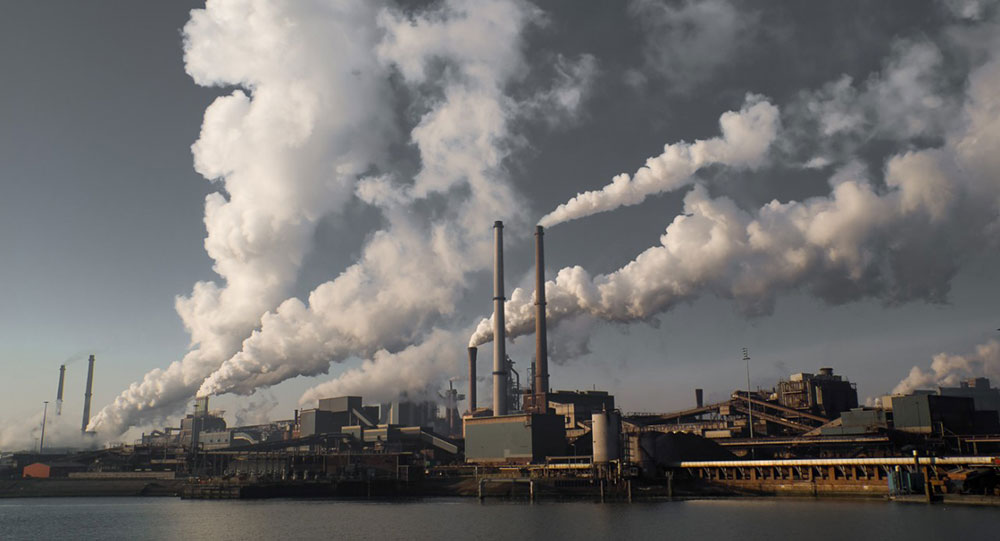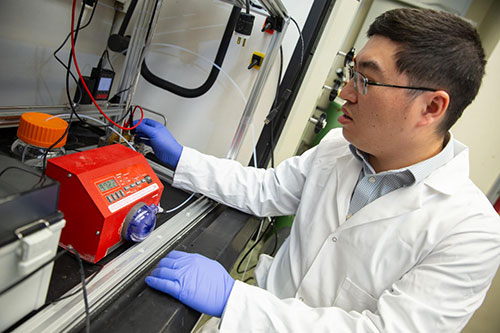CO2 Conversion Helps Industry, Addresses Climate
National research team led by University of Cincinnati professor develops more efficient system to address climate change
February 20, 2024
By Michael Miller
 enlarge
enlarge
UC Associate Professor Jingjie Wu is working on new technology to convert carbon dioxide into ethylene in his chemical engineering lab. Photo/RMitsch/Unsplash
The following news release was issued by the University of Cincinnati. Researchers from the U.S. Department of Energy’s (DOE) Brookhaven National Laboratory made important contributions to this research, including elucidating the characteristics and mechanism of a catalyst involved in converting carbon dioxide to ethylene, a valuable precursor for making a wide variety of products. The work at Brookhaven was funded in part by the Goldhaber Distinguished Fellowship awarded to Juan D. Jimenez and a DOE Early Career Award to Sanjaya D. Senanayake, who were co-authors on the research paper from Brookhaven Lab’s Chemistry Division. In addition, researchers used in situ X-Ray Absorption Spectroscopy at the Inner-Shell Spectroscopy (ISS, 8-ID) and Quick X-Ray Absorption and Scattering (QAS, 7-BM) beamlines at the National Synchrotron Light Source II (NSLS-II), a DOE Office of Science user facility, supported in part by the Synchrotron Catalysis Consortium. For more information about Brookhaven Lab’s contributions to this research, contact: Karen McNulty Walsh, kmcnulty@bnl.gov, (631) 344-8350.
Engineers at the University of Cincinnati created a more efficient way of converting carbon dioxide into valuable products while simultaneously addressing climate change.
In his chemical engineering lab in UC’s College of Engineering and Applied Science, Associate Professor Jingjie Wu and his team found that a modified copper catalyst improves the electrochemical conversion of carbon dioxide into ethylene, the key ingredient in plastic and a myriad of other uses.
Ethylene has been called “the world’s most important chemical.” It is certainly among the most commonly produced chemicals, used in everything from textiles to antifreeze to vinyl. The chemical industry generated 225 million metric tons of ethylene in 2022.
 enlarge
enlarge
In his chemical engineering lab, Associate Professor Jingjie Wu experiments with new ways to convert carbon dioxide into useful industrial products. Photo/Andrew Higley/UC Marketing + Brand
Wu said the process holds promise for one day producing ethylene through green energy instead of fossil fuels. It has the added benefit of removing carbon from the atmosphere.
“Ethylene is a pivotal platform chemical globally, but the conventional steam-cracking process for its production emits substantial carbon dioxide,” Wu said. “By utilizing carbon dioxide as a feedstock rather than depending on fossil fuels, we can effectively recycle carbon dioxide.”
The study was published in the journal Nature Chemical Engineering.
Wu’s students, including lead author and UC graduate Zhengyuan Li, collaborated with Rice University, Oak Ridge National Laboratory, Brookhaven National Laboratory, Stony Brook University and Arizona State University. Li received a prestigious graduate student award last year from the College of Engineering and Applied Science.
The electrocatalytic conversion of carbon dioxide produces two primary carbon products, ethylene and ethanol. Researchers found that using a modified copper catalyst produced more ethylene.
“Our research offers essential insights into the divergence between ethylene and ethanol during electrochemical CO2 reduction and proposes a viable approach to directing selectivity toward ethylene,” lead author Li said.
“This leads to an impressive 50% increase in ethylene selectivity,” Wu said. “Ideally, the goal is to produce a single product rather than multiple ones.”
 enlarge
enlarge
Brookhaven Lab-affiliated study co-authors: Shuting Xiang (Stony Brook University/Chemistry), Juan D. Jimenez (Chemistry), Lu Ma (NSLS-II), Anatoly Frenkel (Stony Brook University/Chemistry), and Sanjaya D. Senanayake (Chemistry)
Sponsored by the U.S. Department of Energy’s Office of Energy Efficiency and Renewable Energy. Its Industrial Efficiency and Decarbonization Office is leading efforts to reduce fossil fuels and carbon emissions in industry wherever possible.
Li said the next step is refining the process to make it more commercially viable. The conversion system loses efficiency as byproducts of the reaction such as potassium carbonate begin forming on the copper catalyst.
“The electrode stability must be improved for commercial deployment. Our next focus is to enhance stability and extend its operation from 1,000 to 100,000 hours,” Li said.
Wu said these new technologies will help make the chemical industry greener and more energy efficient.
“The overarching objective is to decarbonize chemical production by utilizing renewable electricity and sustainable feedstock,” Wu said. “Electrifying the conversion of carbon dioxide to ethylene marks a significant stride in decarbonizing the chemical sector.”
2024-21733 | INT/EXT | Newsroom









